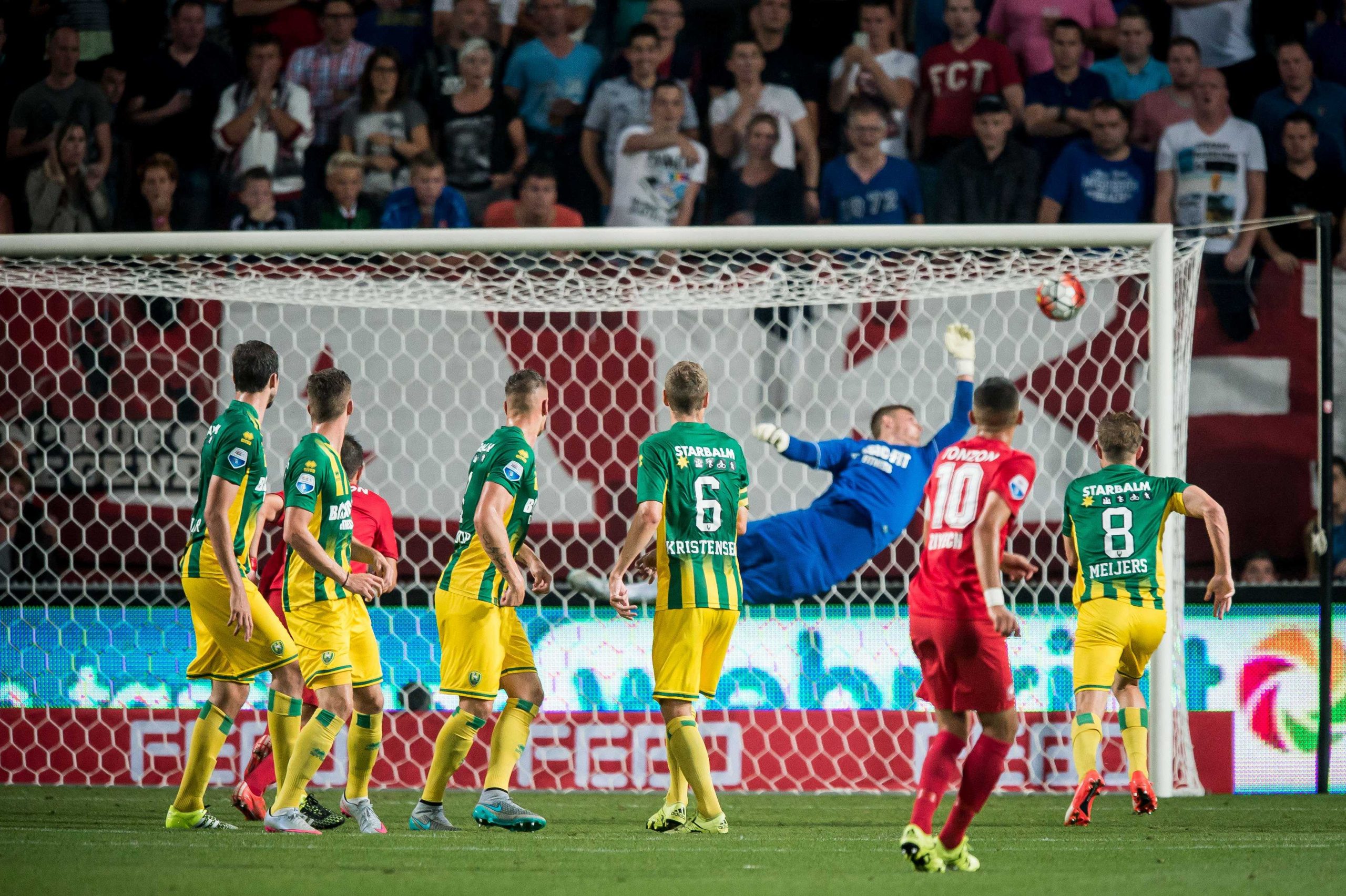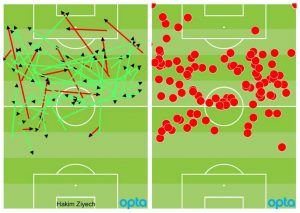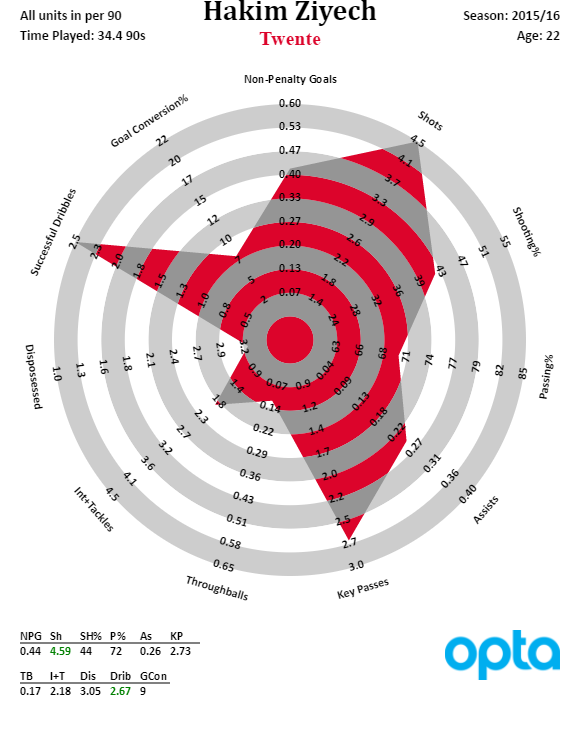
In the Dutch media, Hakim Ziyech has come to be known as ‘Hakim the Silent’. Since the start of 2016, he no longer attends press conferences or interviews of any sort; Ziyech and his agent feel they do not want his comments to be misinterpreted, leading to a vilification of the player in the media. After all, that was what transpired after Ziyech, the then-captain lashed out publicly at essentially everyone associated with the club, following the sacking of Alfred Schreuder (he was soon stripped of the captaincy). Barring some social media activity now and then, Hakim Ziyech remains a bit of an enigma off the field.
He has let his on-pitch performance do the talking mostly and there Ziyech has been anything but enigmatic.
Hakim Ziyech’s two years at Twente have probably turned out both the way he wanted and not the way he wanted. On a personal level, the Dronten-born midfielder has seen amazing growth in his skills and ability to influence matches. However, this has all taken place on board the Twentitanic, a rapidly-sinking ship hit by the Doyen controversy iceberg last season off the pitch and a floundering ghost of a team on the pitch. Ziyech has been the band that continued playing even as chaos erupted and consumed the ship.
For the most part of the last two years, Hakim Ziyech has carried the Twente team. In moments of defeat and debility, the Moroccan has been the one that everyone looked to for a spark, for a way back into a match.
Naturally, the centrality of Ziyech to Twente as a club directly translated onto the pitch. The fact that his teammates depended on him to deliver so much meant that he got freedom in his movement and decision-making on the ball. A ‘true' No. 10 in an era where playmakers are increasingly expected to be multifunctional, Ziyech filled the void of creativity left by Dusan Tadic, who albeit operated from the left wing. The 23-year-old occupies a central role just behind the frontline, but as many attacking midfielders do, often finds himself playing further forward, in line with if not ahead of the striker. Ziyech is equally smart when there is space behind the defence, as well as in tight spaces, when defenders are closing him down.
While extrapolating from one performance is not ideal, a game that really showcased Ziyech's ability as the main man, came in a heavy 1-4 defeat to ADO Den Haag a year ago.

R: Ziyech's touch map, showing his influence in halfspaces
ADO took the lead quickly within the first half hour, and as Twente looked to pick themselves up, they looked to Ziyech. The Moroccan had the most touches — 103 in total — and most of these came in the halfspaces (as seen in the touch map), which is the area between the flanks and the centre, if the pitch is divided into 5 equal parts, lengthwise. Operating in this region gives the player the opportunity to play a forward pass over a backward pass as well as being more decisive in moving the play forward. The freedom that Ziyech is afforded in his #10 role is thus well-expended in such a way, since 56 out of the 79 passes he played went forward to a teammate.
The Twente No.10 floats all across the pitch, although his decisive actions tend to come more from the halfspaces. In general, this makes marking Ziyech difficult; PEC Zwolle’s Wout Brama acknowledged last season that trying to man-mark the slender midfielder was an essentially futile endeavour. Furthermore, Ziyech has consistently put up some of the highest numbers for key passes in every full season he has played in the Eredivisie, since making the step-up from youth/reserve level.

Putting up good assists and/or key passes numbers as a young player generally bodes well as an indicator of the player’s potential and ceiling, as Ted Knutson detailed. To quote Ted, “(The skill of young players producing high number of assists) is the modern attack. You need creative guys who can run make runs, fill space, and have the vision to produce great final balls. Pair them with efficient finishers, and the combination makes it exceptionally difficult for teams to mark you in the attacking third.”
This is the type of player Hakim Ziyech has proven himself to be, especially over the last year in the Eredivisie. Even from his days at Heerenveen, there were comparisons (premature then, but somewhat valid) to Mesut Özil and now, it is not too far-fetched to liken Ziyech’s skill on the ball to the German; his control of the ball even when dribbling is impressive and his passes are often well-weighted, if not silky.

In addition to crosses, a large portion of Ziyech’s key passes come from set pieces, with his corners in particular being a strong point. His awareness of space is fantastic, as shown before. In 2014/15, Ziyech had relatively better teammates in Jesus Manuel Corona and Renato Tapia, who were in sync with the nimble-footed midfielder and each found themselves on the receiving end of a Ziyech assist four times over the season. But even when these two departed for greener pastures as the Twentitanic started sinking, Ziyech continued creating. This is highlighted by the fact that his key passes numbers have increased between 2014/15 and 2015/16, even though the assist tally went down. Such fluctuations are rarely the fault of the creator and the growth in the key pass metric from an already high level is an encouraging trend.
Ziyech is the type of player who finds it second nature to change direction quickly and flummox defenders. His light frame gives him mobility and he accelerates just as smoothly with the ball as he does without it. Over the last three seasons, he has attempted an average of 4.7 dribbles per 90 minutes, and finds success roughly half of the time.
As such, when his teammates aren’t finding the target enough, Ziyech is more than capable of taking the mantle himself. Being the focal point of his side, in every sense of the term, means that Ziyech takes a lot of shots, from both open play and freekick situations. He also finds the target pretty consistently, with a percentage of 41.3% of his shots being on target over the last two seasons. With a propensity to shoot from range, he lags a bit in terms of actual conversion, but in a side with better teammates and with more guidance, he should develop a more keen sense of picking his shots well. There is a certain unpredictability about Ziyech, which is what also makes him lethal; he can seem quiet but then suddenly emerge in a good position and find a goal or create an opening for a teammate. That he could produce such moments with some regularity over the last season is impressive.

Ziyech’s glaring weakness is his physique — or rather, the lack thereof. While his balance is good, being fleet-footed can’t always get the 23-year-old out of trouble and at times, this can lead to him losing the ball when he attempts a dribble and ends up being outmuscled.
However, with enough strength and conditioning work, this should not be a major obstacle in preventing clubs from being interested in him. Riyad Mahrez, for example, showed last season, that one does not necessarily need to be of bulky build to succeed as a winger or creative midfielder in a league as renowned for being physical as the Premier League.
As far as his best position goes, there is very little space for discussion. As Ajax boss Peter Bosz put it, "Ziyech should not be played on the wing. He belongs at the #10 role; he's a creative boy who does not belong on the flanks." The midfielder himself is obsessed with everything #10, he even has it stitched into his gloves. He is not the type of player who would thrive in a tactically rigid role; growing up playing football on the streets, Ziyech is an effervescent attacking presence but can only perform as such if he is given the tactical freedom to dictate play.
Ziyech might also take his time to develop into more of a team player, which has some irony in as much as the reason for him seeming ‘selfish' at Twente was in taking up responsibility in situations of need. Naturally, if/when he moves to a bigger club, he will have teammates of better calibre and thus, he will have to refrain from trying to do everything himself and sometimes taking that too far. Most teams also expect attacking midfielders to be multi-functional and help out in defending and pressing, and this too is an area Ziyech should look to improve and develop in.
However, the fact that we are well into August and Ziyech still plays for Twente (who were nearly relegated over the summer due to their financial irregularities) remains almost a Tupac-level mystery now. There has been interest from some foreign clubs, while PSV and Ajax have made enquiries too. The Dutch clubs are likely to be priced out by the €12million ‘base' fee price tag that Twente have slapped on him. All of Borussia Dortmund, Roma, Fenerbahce, Inter Milan, Napoli, Burnley and Everton have been linked to the 23-year-old at some point over the last few weeks — the first three being named by Twente director Ted van Leeuwen himself as clubs willing to pay the minimum fee.
It is possible that Ziyech himself is waiting for a ‘big' club to show real, concrete interest, hence perhaps why reported talks with Burnley were unsuccessful. Most of the other clubs should be of sufficient level for Ziyech to benefit from the move as a player, though naturally he will have to go through the adaptation and acclimatisation process before producing performances of the calibre he showed in the Netherlands.
Given the ridiculously high fees thrown around this summer, the club who eventually picks up Hakim Ziyech for the peanuts sum of €12m or so, might prove to have made a shrewd investment.